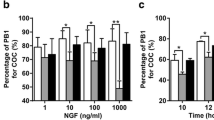Abstract
The present study was designed to investigate the localization of endothelial nitric oxide synthase (eNOS) in porcine oocytes and its possible function during in vitro development. RT-PCR and immunoblotting analyses revealed the presence of eNOS in the oocytes prepared from small follicles, with an amplified product of 456 bp and an apparent mol wt of 130 kDa, respectively. The synthesis of oocyte NO was suppressed during a 72-h culture of cumulus-oocyte complexes in the presence of follicle-stimulating hormone (FSH), but not luteinizing hormone (LH). However, the decrease in NO synthesis did not result from the levels of eNOS mRNA and its protein, as revealed by analyses of RT-PCR and Western blot analysis, suggesting that expression of oocyte eNOS is not dependent upon gonadotropin stimulation. In proliferated cumulus cells, LH receptor mRNA expression was detected after a 48-h culture with FSH, as revealed by RT-PCR analysis. mRNA expression was inhibited by an NO-releasing agent (S-nitroso-N-acetyl-DL-penicillamine) after an additional 24-h culture. These results suggest that oocytes may release eNOS-derived NO as a signal for somatic cells to steadily suppress the development of cumulus cells, if not FSH stimulation. Conversely, the synthesis of NO is suppressed during the action of FSH on the cumulus cells with no changes in eNOS expression.
Similar content being viewed by others
References
Bredt DS, Hwang PM, Glatt CE, Lowenstein C, Reed RR, Snyder SH: Cloned and expressed nitric oxide synthase structurally resembles cytochrome P-450 reductase. Nature 351: 714–718, 1991
Lamas S, Marsden PA, Li GK, Tempst P, Michel T: Endothelial nitric oxide synthase: Molecular cloning and characterization of a distinct constitutive enzyme isoform. Proc Natl Acad Sci USA 89: 6348–6352, 1992
Lowenstein CJ, Glatt CS, Bredt DS, Snyder SH: Cloned and expressed macrophage nitric oxide synthase contrasts with the brain enzyme. Proc Natl Acad Sci USA 89: 6711–6715, 1992
Van Voorhis BJ, Moore K, Strijbos PJL, Nelson S, Baylis SA, Grzybicki D, Weiner CP: Expression and localization of inducible and endothelial nitric oxide synthase in the rat ovary. J Clin Invest 96: 2719–2726, 1995
Jablonka-Shariff A, Olson LM: Hormonal regulation of nitric oxide synthases and their cell-specific expression during follicular development in the rat ovary. Endocrinology 138: 460–468, 1997
Ellman C, Corbett JA, Misko TP, McDaniel M, Beckerman KP: Nitric oxide mediates interleukin-1-induced cellular cytotoxicity in the rat ovary: A potential role for nitric oxide in the ovulatory process. J Clin Invest 92: 3053–3056, 1993
Ben-Shlomo I, Kokia E, Jackson MJ, Adashi EY, Payne DW: Interleukin-1β stimulates nitrite production in the rat ovary: Evidence for heterologous cell-cell interaction and for insulin-mediated regulation of the inducible isoform of nitric oxide synthase. Biol Reprod 51: 310–318, 1994
Chun S-Y, Eisenhauer KM, Kubo M, Hsueh AJW: Interleukin-1β suppresses apoptosis in rat ovarian follicles by increasing nitric oxide production. Endocrinology 136: 3120–3127, 1995
Shukovski L, Tsafriri T: The involvement of nitric oxide in the ovulatory process in the rat. Endocrinology 135: 2287–2290, 1995
Hattori M-A, Sakamoto K, Fujihara N, I. Kojima I: Nitric oxide: A modulator for the epidermal growth factor receptor expression in developing ovarian granulosa cells. Am J Physiol 270: C812–C818, 1996
Bonello N, Mckie K, Jasper M, Andrew L, Ross N, Braybon E, Brannstrom M, Norman RJ: Inhibition of nitric oxide: Effects on interleukin-1β-enhanced ovulation rate, steroid hormone, and ovarian leukocyte distribution at ovulation in the rat. Biol Reprod 54: 436–445, 1996
Yamauchi J, Miyazaki T, Iwasaki S, Kishi I, Kuroshima M, Tei C, Yoshimura Y: Effects of nitric oxide on ovulation and ovarian steroidogenesis and prostaglandin production in the rabbit. Endocrinology 138: 3630–3637, 1997
Adams ML, Mock B, Truong R, Cicero TJ: Nitric oxide control of steroidogenesis: Endocrine effects of NG-nitro-L-arginine and comparisons to alcohol. Life Sci 50: 35–40, 1992
Van Voorhis BJ, Dunn MS, Snyder GD, Weiner CP: Nitric oxide: An autocrine regulator of human granulosa-luteal cell steroidogenesis. Endocrinology 135: 1799–1806, 1994
Punta KD, Charreau EH, Pignataro OP: Nitric oxide inhibits Leydig cell steroidogenesis. Endocrinology 137: 5337–5343, 1996
Olson LM, Jones-Burton CM, Jablonka-Shariff A: Nitric oxide decreases estradiol synthesis of rat luteinized ovarian cells: Possible role for nitric oxide in functional luteal regression. Endocrinology 137: 3531–3539, 1996
Jablonka-Shariff A, Olson LM: The role of nitric oxide in oocyte meiotic maturation and ovulation: Meiotic abnormalities of endothelial nitric oxide synthase knock-out mouse oocytes. Endocrinology 139: 2944–2954, 1998
Hattori M-A, Nishida N, Takesue K, Kato Y, Fujihara N: FSH suppression of nitric oxide synthesis in porcine oocytes. J Mol Endocrinol 24: 65–73, 2000
Loosfelt H, Misrahi M, Atger M, Salesse R, Vu Hai-Luu Thi MT, Jolivet A, Guiochon-Mantel A, Sar S, Jallal B, Garnier J, Milgrom E: Cloning and sequencing of porcine LH-hCG receptor cDNA: Variants lacking transmembrane domain. Science 245: 525–528, 1989
Tsukahara H, Gordienko DV, Goligorsky MS: Continuous monitoring of nitric oxide release from human umbilical vein endothelial cells. Biochem Biophys Res Commun 193: 722–729, 1993
Hattori M-A, Takesue K, Nishida N, Kato Y, Fujihara N: Inhibitory effect of retinoic acid on the development of immature porcine granulosa cells to mature cells. J Mol Endocrinol 25: 53–61, 2000
Nishida N, Takesue K, Hattori M-A, Kato Y, Wakabayashi K, Fujihara N: Modulatory action of nitric oxide on the expression of transcription factor genes, c-fos and c-jun, in developing porcine granulosa cells in vitro. J Reprod Dev 46: 167–175, 2000
Brower PT, Schultz RM: Intercellular communication between granulosa cells and mouse oocytes: Existence and possible nutrional role during oocyte growth. Dev Biol 90: 144–153, 1982
Eppig JJ, Pendola FL, Wiggtesworth K: Mouse oocytes suppress cAMP-induced expression of LH receptor mRNA by granulosa cells in vitro. Mol Reprod Dev 49: 327–332, 1998
Author information
Authors and Affiliations
Corresponding author
Rights and permissions
About this article
Cite this article
Hattori, MA., Takesue, K., Kato, Y. et al. Expression of endothelial nitric oxide synthase in the porcine oocyte and its possible function. Mol Cell Biochem 219, 121–126 (2001). https://doi.org/10.1023/A:1010830507846
Issue Date:
DOI: https://doi.org/10.1023/A:1010830507846




